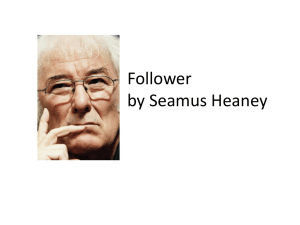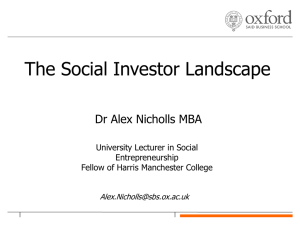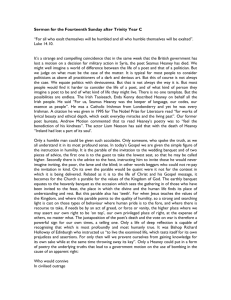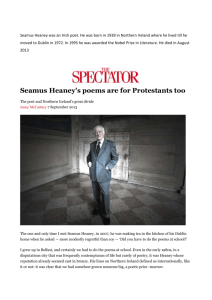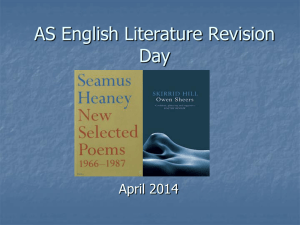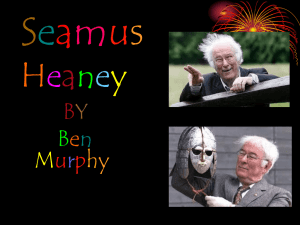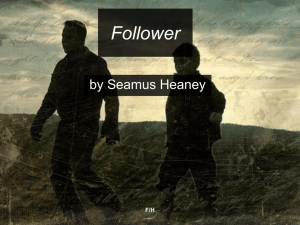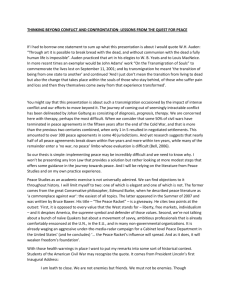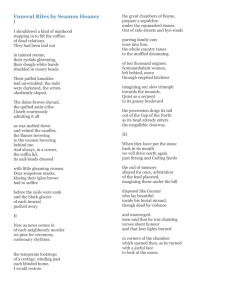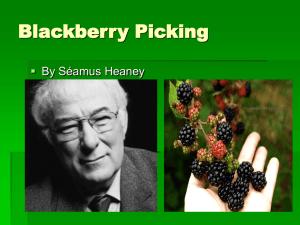Funeral Rites by Seamus Heaney Analysis notes
advertisement
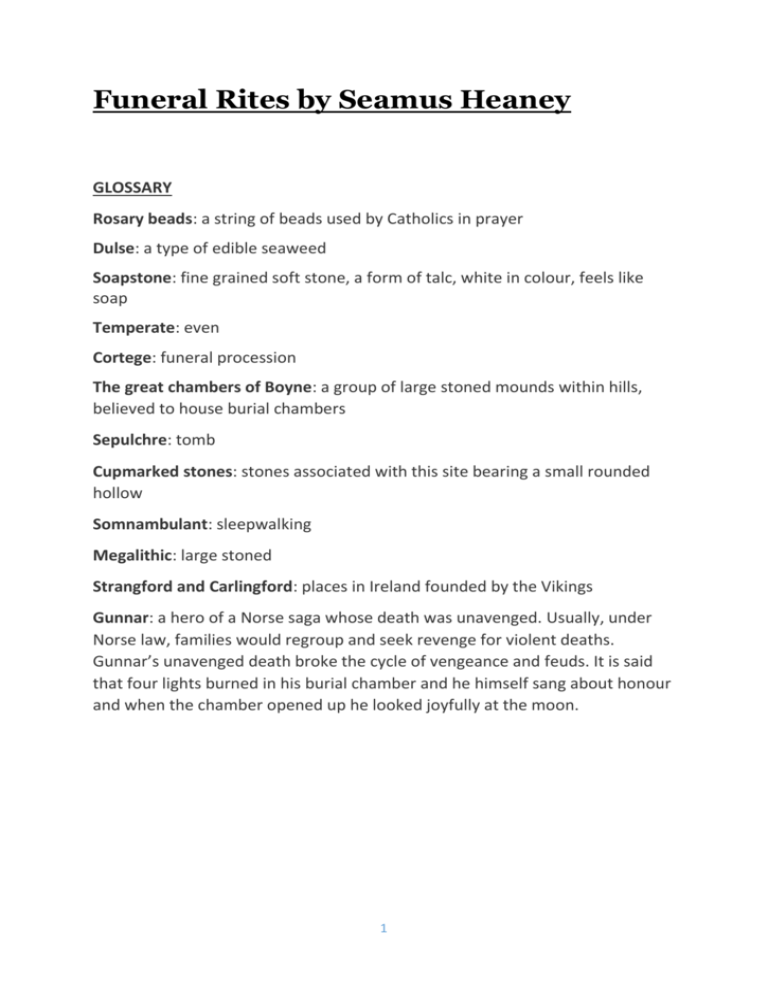
Funeral Rites by Seamus Heaney GLOSSARY Rosary beads: a string of beads used by Catholics in prayer Dulse: a type of edible seaweed Soapstone: fine grained soft stone, a form of talc, white in colour, feels like soap Temperate: even Cortege: funeral procession The great chambers of Boyne: a group of large stoned mounds within hills, believed to house burial chambers Sepulchre: tomb Cupmarked stones: stones associated with this site bearing a small rounded hollow Somnambulant: sleepwalking Megalithic: large stoned Strangford and Carlingford: places in Ireland founded by the Vikings Gunnar: a hero of a Norse saga whose death was unavenged. Usually, under Norse law, families would regroup and seek revenge for violent deaths. Gunnar’s unavenged death broke the cycle of vengeance and feuds. It is said that four lights burned in his burial chamber and he himself sang about honour and when the chamber opened up he looked joyfully at the moon. 1 Introduction Seamus Heaney’s poem “Funeral Rites” emphasizes social awareness, especially in its overt references to the violent "Troubles” between Catholics and Protestants in Northern Ireland. Seamus Heaney describes the traditional Irish funeral with the body lying in an open coffin in the best room in the house with friends and relatives calling to pay respects. The latter parts are allegorical and involve Irish history and heroes interwoven with modern Irish politics. Funeral Rites combines the personal and cultural - the private and the public responses to deaths that take place in Heaney's family and wider community. Heaney calls for the deaths to be marked by private and public ritual. It is through the rituals of death that resolution and healing can take place. It is through ritual that the pain of loss and anger can become dissipated and order, stability and peace can be restored. Each section, in fact, is strongly social in emphasis. The first section focuses on family funerals The second section focuses on the burial of someone killed in “The Troubles” The third section alludes to early mythology and to a burial from centuries earlier. 2 I I shouldered a kind of manhood stepping in to lift the coffins of dead relations. They had been laid out in tainted rooms, their eyelids glistening, their dough-white hands shackled in rosary beads. Their puffed knuckles had unwrinkled, the nails were darkened, the wrists obediently sloped. The dulse-brown shroud, the quilted satin cribs: I knelt courteously admiting it all as wax melted down and veined the candles, the flames hovering to the women hovering behind me. And always, in a corner, the coffin lid, its nail-heads dressed with little gleaming crosses. Dear soapstone masks, kissing their igloo brows had to suffice before the nails were sunk and the black glacier of each funeral pushed away. 3 II Now as news comes in of each neighbourly murder we pine for ceremony, customary rhythms: the temperate footsteps of a cortège, winding past each blinded home. I would restore the great chambers of Boyne, prepare a sepulchre under the cupmarked stones. Out of side-streets and bye-roads purring family cars nose into line, the whole country tunes to the muffled drumming of ten thousand engines. Somnambulant women, left behind, move through emptied kitchens imagining our slow triumph towards the mounds. Quiet as a serpent in its grassy boulevard the procession drags its tail out of the Gap of the North as its head already enters the megalithic doorway. 4 III When they have put the stone back in its mouth we will drive north again past Strang and Carling fjords the cud of memory allayed for once, arbitration of the feud placated, imagining those under the hill disposed like Gunnar who lay beautiful inside his burial mound, though dead by violence and unavenged. men said that he was chanting verses about honour and that four lights burned in corners of the chamber: which opened then, as he turned with a joyful face to look at the moon. 5 The First Section Eight quatrains with variable line length between 3 and 8 syllables Multiple use of enjambment Assonance In this first section Heaney focuses on family deaths. We are immediately reminded of the poem Mid Term Break in which Heaney writes about the death of his younger brother. Heaney still at school is called upon to take up the responsibilities of one of the chief mourners within his family and wider community. Private grief is contrasted with Heaney's public display of grief. In this poem he is older now. Tall enough to be one of the coffin bearers and experienced enough to understand and cope with the loss of a number of family members. He describes in detail the corpses he viewed, presumably those of elderly or sickly relatives who had died “natural” deaths, not deaths caused by violence. This opening section of the poem is the least overtly “social,” and one of its main purposes is to contrast with the sections that come later, especially section II. But only just because this humility and fragility is picked up in the opening phrase 'I shouldered a kind of manhood'. The pun on the word 'shouldered' picks up the physical and emotional role that Heaney now plays within his community. The phrase, 'a kind of' is informal and conversational. The poem draws from everyday and ordinary experiences. We have to make assumptions about these family deaths as the focus of the poem here is on the description of the rooms and the bodies of the dead. We are on familiar ground here. We are reminded of poems such as 'The Grauballe Man' and 'The Tollund Man'. However unlike 'The Grauballe Man' and 'The Tollund Man' - whose deaths were violent there is no direct indication that Heaney's family deaths referred to here are violent as well. However Heaney does write elsewhere of family casualties of the violence in Northern Ireland in poems like 'The Strand at Lough Beg'. Despite there being no direct reference to violent deaths the description of his relatives seems to suggest Heaney's relatives are all laid out in a single room all at the same time reminding us of the 'Stockinged corpses/Laid out in the farmyards...' in 'The Tollund Man'. If Heaney was describing a family massacre we might expect a more detailed, more explicit and direct account of it. Instead the phrase 'And always, in a corner,/the coffin lid,' the adverb 'always' indicates the progress of time. So I think these are the natural deaths of elderly relatives. Perhaps the 'Their puffed knuckles/had unwrinkled' suggests age. The contrasting nouns of the first section's 'deaths' with the second section's 'murders' makes this point. But it is not clear - perhaps deliberately. 6 But Heaney does something similar with these corpses as he does with the other violent bog corpses of say 'Bog Queen' or 'Punishment'. What he does is soften them. He transforms death into something of beauty, something familiar and comforting. The distances that death creates are shortened through a series of phrases culminating with 'Dear soapstone masks,/Kissing their igloo brows...'. In the selective descriptions of the corpses and the paraphernalia of death - for example the 'little gleaming crosses' and 'rosary beads' these deaths are turned into portraits of love, respect and even awe. They become a kind of work of art. The Second Section Seven quatrains Lines between 4-7 syllables No rhyme scheme 5 sentence structure with punctuation mainly end of line; almost half of the lines enjambed Assonance Vocabulary of quiet calm: purring/cars somnambulant In the second section there is a broadening of the scope of the poem. Heaney's focus turns from family deaths to 'neighbourly murder[s]'. In this term he is referring to the sectarian violence that dominated Northern Irish politics during the mid- twentieth century. This violence is an expression of the conflict between two cultures, religions and national identities. On one side is the Roman Catholic and Republican community. Their goal is a united Ireland independent of British rule and influence. This community draws its identity from pre-history, from Viking, Celtic and the early Christianity of Patrick in the 5th century and the Classical civilization. The second group are Protestant, British and Unionist. A country occupied and deeply influenced by the Roman Empire and Norman France as well as Viking. Britain is seen as a seafaring nation that developed a strong culture of trading, industrialisation and colonisation. The conflict between these two groups has developed over hundreds of years and Heaney refers to this conflict specifically in the second and third sections of the poem. We are shocked by the phrase 'neighbourly murder' - the idea of murders taking place within communities is picked up in poems like 'The Tollund Man' and 'Punishment'. These murders have taken place on British soil. And not one murder but hundreds of murders stretched out over decades. The need for ritual is described as instinctive and powerful. Yet Heaney describes the rituals as comforting and peaceful. 7 The phrase 'temperate footsteps' the adjective 'temperate' picks up on moderation and restraint rather than anger and revenge the traditional response to sectarian violence. Heaney draws on the distant and recent Irish past to give the rituals of death and peace authority and legitimacy. He wants to break the culture of violence so embedded with the Roman Catholic culture. So he makes a reference to the burial 'chambers of the Boyne'. These are neolithic burial mounds built around 2000 years ago. The markings link the stones to the bronze-age. Heaney imagines a funeral procession. It moves to the sounds of thousands of car engines as a whole nation mourns its deaths. The sound of the engines becomes the music for these imagined funerals. Heaney is making a point about the traditional rituals of sectarian funerals accompanied with gunshots, drumming and tribal music. The picture here is one of peace and resolution. It is 'somnambulant women' the widows that contemplate the 'triumph' of a peaceful funeral picked up in the noun phrase, 'Quiet as a serpent' - a Celtic symbol. The Third Section Five quatrains Variable line length No rhyme scheme Emjambment Assonance Consonance Section III is far less clear than the first two sections It has sometimes been criticized on that account. The speaker seems to allude to ancient Irish or even ancient Norse mythology He also seems to allude to Christian myths of the burial and resurrection of Christ, as in the first two lines When they have put the stone back in its mouth And the last three lines of the section which opened then, as he turned with a joyful face to look at the moon. Section III alludes to the distant past in order to evoke a possible future when violent deaths, of Christians killing Christians, might someday cease. Heaney is desperate for some resolution to the situation in Ireland. 8 For Heaney I think that conventional Christianity - in the form of Roman Catholicism and Protestantism - has failed. It cannot offer Ireland the solutions it needs. It exists in Ireland as a tribal, sectarian and empty of spiritual power. Only representing and reduced to the political identities of two conflicting ideologies. Therefore he turns to a pre Christian spiritual tradition for inspiration. Heaney is vague about what the past can offer. He seems to have turned his back on Christ and the full meaning of that sacrifice. Instead he looks to Ireland's ancient past and the figure of Gunnar - a great Norse warrior. He offers a message of peace to these divided communities. In the final section of the poem Heaney offers his readers an alternative to a barbaric image we have of the past of warring tribes motivated by hatred and revenge. He uses this image to guide the present and future state of Ireland. He continues to imagine a funeral where personal pain and loss are no longer transformed into hatred, anger, and revenge. 9
